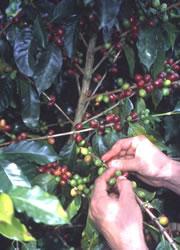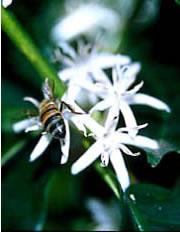 Coffee growers reap the financial rewards of neighbouring forest.© PNAS
Coffee growers reap the financial rewards of neighbouring forest.© PNASTropical forests can boost the coffers of nearby coffee plantations. Forest-dwelling bees cross-pollinate nearby bushes, raising coffee yields by up to 20% and farm incomes by up to 7%.
Areas of forest are often cut down to make room for coffee plantations, so the researchers hope the find will help persuade coffee farmers to conserve tropical forest close to their crops. "Ecosystem conservation can benefit biodiversity and people," says Taylor Ricketts from Stanford University, California, who contributed to the study.
Coffee ranks among the five most valuable agricultural exports from developing nations. Some 25 million people worldwide are involved in its production. But the plant grows best in the high, humid locations favoured by tropical forests, so conservationists and producers are deadlocked over the best use of land.
Bountiful bushes
Ricketts's team studied a selection of coffee bushes growing in the Finca Santa Fe, a large coffee farm in the Valle General, Costa Rica, which is bordered by tropical forest. The forest is home to a mix of non-native feral honeybees (Apis mellifera) and ten species of native "stingless" bees (of the family Apidae Meliponinae).
The coffee grown there (Coffea arabica) can self-pollinate, but the researchers wanted to see if extra pollination from neighbouring bees could increase the yield. To measure the effectiveness of the bees, they tested how bee-pollinated bushes measured up against super-saturated plants that had had large amounts of pollen added by hand.
Pollinating the bushes by hand increased the yield of coffee by around 20%. Bee-pollination boosted the yield by just as much, showing that the bees are extremely efficient at pollinating the plants. However, the yield only increased if the bushes were within a kilometre of the forest, the team report in the Proceedings of the National Academy of Sciences1.
When the plants were further away from the forest, bees had little effect on the coffee yield. "This shows that it's no good siting conservation areas away from people," says Ricketts. For farmers to benefit, the forests must be close by.
Plants in the one-kilometre range also had 27% fewer peaberries, which are the small, deformed seeds that result from poor pollination and produce inferior coffee. So bees improved both coffee quality and yield.
Cash incentives
 A wild honeybee (Apis mellifera) visits a coffee flower, bringing pollen from other plants to fertilize it.© PNAS
A wild honeybee (Apis mellifera) visits a coffee flower, bringing pollen from other plants to fertilize it.© PNASThe economic benefits of such pollination can be huge. Ricketts's team estimates that, in Finca Santa Fe, the increase due to bees of the yield from 35 hectares of forest translates to an extra US$60,000 a year for the coffee plantation.
Costa Rica's innovative Payments for Environmental Services Payments scheme pays landowners around US$42 a year for each hectare of forest they conserve, but this is only a fraction of the natural benefits provided by such nearby forest.
"Conservationists often invoke 'ecosystem services' as a justification for conserving wild areas, but we have few examples where the value of conserving natural habitat has been clearly demonstrated. This is one of them," says conservation biologist Claire Kremen from Princeton University in New Jersey.
Ricketts's team now hopes to visit Costa Rica and promote the benefits of interlacing farming and forests to environmental ministers and landscape cooperatives.
Around two-thirds of the crops we eat are partially dependent on animals for pollination. So it is likely that other agricultural plants, such as watermelons and sunflowers, will also benefit from nearby patches of biodiversity. "Such areas may also provide natural enemies of crop pests," says Kremen.
